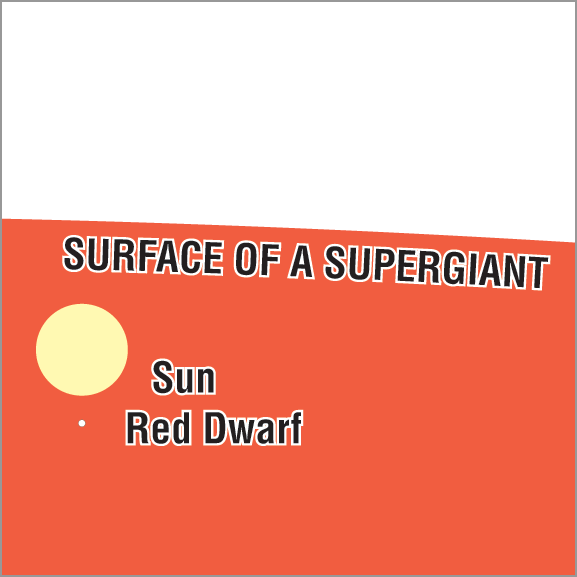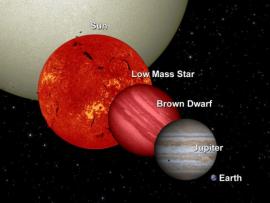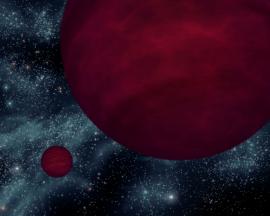
The words astronomers use to describe stars evoke the fairy tales of childhood: white dwarfs, red giants, red dwarfs, and blue giants, among others.
The characteristic that distinguishes a giant star from a dwarf star is size, which depends on the star’s mass and its stage in life. The characteristic that distinguishes a red star from a blue star is temperature. When an iron bar is first removed from a blacksmith’s forge, it appears white hot. As it cools, its color changes from bright orange to dull red, then black.
You now know something about red dwarfs just by reading the name: They have relatively low surface temperatures and mass.
 A brown dwarf and a red dwarf are shown in comparison to the sizes of the Sun and the planet JupiterIn astronomical jargon, most red dwarfs are classified as class “M” dwarfs. The M comes from a system that classifies stars based on surface temperature. The surfaces of M dwarfs are around 4,500 degrees Fahrenheit (2,500 C) — less than half the surface temperature of the Sun.
A brown dwarf and a red dwarf are shown in comparison to the sizes of the Sun and the planet JupiterIn astronomical jargon, most red dwarfs are classified as class “M” dwarfs. The M comes from a system that classifies stars based on surface temperature. The surfaces of M dwarfs are around 4,500 degrees Fahrenheit (2,500 C) — less than half the surface temperature of the Sun.
M dwarfs recently lost their title as the coolest stars, though, with the discovery of L dwarfs, a class of cool, dim objects that barely qualify as stars.
Mass determines nearly everything about a star: its temperature, its color, and how rapidly its interior evolves. The amount of energy flowing through the star’s surface determines its temperature and color.
A star emits more or less energy depending on the pressure in its core. The more mass, the higher the pressure. Because their masses are so low, the core pressure in red-dwarf stars is low, so the stars are cool, red, and last a long, long time — perhaps a trillion years or longer, compared to about 10 billion years for a star like the Sun.
Just how little mass is required to instigate the nuclear fusion process motivates much contemporary research. If there’s too little mass, the central pressure never climbs high enough to trigger fusion. But add a little mass and fusion begins — and a star is born. The “star/not-a-star” mass region seems to lie between seven and eight percent of the mass of the Sun.
What is a brown dwarf?
Even before the recent discovery of L dwarfs, astronomers knew of a few objects that clearly fell below the star/not-a-star mass limit. The act of formation provides enough heat for the youngest of these objects to produce visible light, just like an iron bar recently removed from the forge. We see them in the process of cooling. Dull red is brownish, hence the name “brown dwarf.”
 Artist’s concept of a planet (left) orbiting a brown dwarfBrown dwarfs are starlike objects that, because of their extremely small size, never achieve the necessary conditions in their cores to sustain the nuclear fusion that powers normal stars. These objects, the extreme lower end of the stellar family, may in fact represent a bridge between the faintest of “true” hydrogen-burning stars and cold gas-giant planets such as Jupiter.
Artist’s concept of a planet (left) orbiting a brown dwarfBrown dwarfs are starlike objects that, because of their extremely small size, never achieve the necessary conditions in their cores to sustain the nuclear fusion that powers normal stars. These objects, the extreme lower end of the stellar family, may in fact represent a bridge between the faintest of “true” hydrogen-burning stars and cold gas-giant planets such as Jupiter.
When a star forms, its eventual size is determined by a wide variety of factors intrinsic to the dense gas cloud in which it was born, but a study of the numbers of different-sized stars clearly shows that stars somewhat smaller than the Sun are the favored model. Enormous stars, such as Eta Carinae — 120 time as massive as the Sun — are extremely rare, while the galaxy is practically brimming over with stars just over half of the Sun’s size.
Stars are limited in how small they can be, however; the high pressures and temperatures necessary for the nuclear fusion that drives a star requires a mass of about seven to eight percent of the Sun’s — about 70-80 times the mass of Jupiter. When a “star” forms below this mass limit, it fails to ignite its nuclear fuel, and glows a dull red color strictly from the heat of its pressurized gases. Such an object is called a “brown dwarf”, for somewhat obvious reasons.